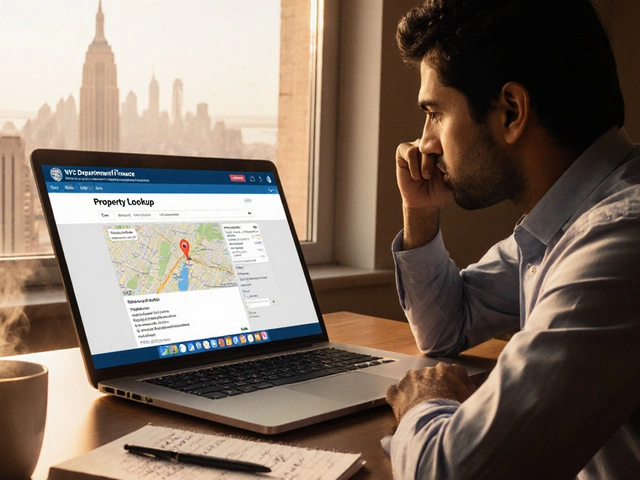People talk about becoming a millionaire like it's just about luck or fancy insider secrets. The truth? Commercial real estate is one arena where real people really do build actual, serious wealth. But it's not some magic shortcut—you need a strategy, some grit, and a stomach for risk.
Think about it: one apartment building, office space, or retail strip can bring in more monthly cash than most day jobs. That's how commercial real estate can turn regular folks into millionaires—if you know what you're doing. Still, it's not just about buying the first warehouse you see on sale. The biggest wins come when you understand things like tenant quality, cash flow, and smart financing. Some people buy, hold, and collect rent for years. Others renovate and flip for a quick win. There’s room for different play styles, but you’ve got to get the basics right.
The truth is, there are plenty of people who have lost money chasing big real estate dreams, too. So, before you rope in your life savings or max out your credit cards, let's get real about how the millionaire math actually works when it comes to commercial property.
- Why Commercial Real Estate Attracts Wealth Seekers
- How Millionaires Build Wealth with Property
- The Numbers: Profit, Risk, and What They Don't Tell You
- Getting In: Capital, Loans, and Leverage
- Common Pitfalls (and Million-Dollar Mistakes)
- Practical Steps to Get Started—For Real
Why Commercial Real Estate Attracts Wealth Seekers
People chasing big wealth often get drawn to commercial real estate for one simple reason: bigger deals usually mean bigger paydays. Unlike single-family homes, commercial properties like office buildings, warehouses, or retail centers can pull in fat rental checks each month. It’s a different league compared to residential real estate—think scaling your income with every square foot managed or rented out.
Here’s the kicker: commercial property doesn’t just create steady, passive income. It can also pile up value as market prices rise. Investors use strategies like value-add (fixing up old buildings), boosting rent, or signing long-term leases with reliable businesses. If you get these things right, the math gets wild, fast.
Another draw is leverage. Banks love lending on commercial deals, so you don’t always need buckets of cash up front. If you put down 20% and the property’s value jumps, you keep the gains, not the bank. Plus, big investors use commercial properties to diversify and lower risk since people always need places to work, shop, and store stuff—especially after the weirdness of 2020 shook up the economy.
Commercial real estate is full of built-in cash flow, tax breaks, and serious upside. 1031 exchanges let you swap one property for another, deferring taxes—which means you can keep growing your portfolio almost tax-free for years.
Let’s look at some quick numbers to show why this game is so attractive:
| Property Type | Typical Annual Return (%) | Average Deal Size |
|---|---|---|
| Office | 7-10 | $1M-$20M |
| Multifamily | 6-10 | $1M-$50M |
| Retail | 5-9 | $1M-$30M |
The secret sauce: more units and higher rents, plus smart financing, make it possible to hit that millionaire goal faster than grinding away at a 9-to-5. That’s why people with big ambitions keep looking at commercial real estate—it’s one spot where effort, strategy, and good timing can seriously change your net worth.
How Millionaires Build Wealth with Property
Most millionaires who made it big in commercial real estate did it by figuring out how to make properties pay for themselves—and then using that momentum to scale up. It’s not just about buying and hoping; it’s a numbers game that’s all about passive cash flow and asset growth.
The first thing to know: rents from commercial property can be way higher than most single-family homes. A local report from 2024 showed mid-sized warehouses in Dallas pulling in net rents of up to $8 per square foot annually, while retail spaces in high-traffic areas charge even more. Stack those rents across multiple tenants, and you start to see major cash.
But it’s not just monthly rent. There’s what pros call “forced appreciation”—when you update, re-tenant, or reposition a property, you can hike rents or cut costs and make the property more valuable. Millionaires love this move because the value boost can be huge with just a few changes. Let’s look at a real example:
| Metric | Before Renovation | After Renovation |
|---|---|---|
| Annual Rental Income | $80,000 | $110,000 |
| Operating Expenses | $40,000 | $38,000 |
| Net Operating Income | $40,000 | $72,000 |
| Estimated Property Value (6% cap) | $666,667 | $1,200,000 |
This is how some people double their net worth with one smart project.
Another key? Leverage. A lot of wealthy investors use loans to buy bigger properties than they could with cash alone, spreading their risk and maximizing returns. Bank financing for commercial deals usually sits around 65-75% loan-to-value, so you’re not tying up all your cash in one place. Once a property is stabilized—meaning it’s running smoothly and mostly rented—folks often refinance, cash out the equity, and use that money for the next buy.
It’s also common for commercial property owners to create partnerships or syndicates, pooling cash and sharing profits and risk. This opens the door for people without millions in the bank but with the right skills or hustle to still get a piece of bigger deals.
Most millionaire owners follow a repeatable process. Here’s the playbook:
- Identify properties with upside (undervalued rents, high vacancy, cosmetic fixers)
- Secure financing with the lowest rates and best terms possible
- Add value: renovate, raise rents, cut unnecessary costs
- Stabilize the asset with quality tenants
- Either hold for ongoing income or refinance and repeat
Bottom line: these folks treat commercial property like a business, not a side hobby. They crunch numbers, look for ways to create value, and always keep hunting for the next opportunity. That’s how the snowball turns into a mountain.
The Numbers: Profit, Risk, and What They Don't Tell You
Everyone loves talking about huge profits in commercial real estate, but what gets glossed over is the reality behind those big numbers. The simple truth? Not every property is a cash machine. The difference between a winner and a loser often comes down to understanding how the money actually flows—plus spotting the stuff nobody advertises.
Here’s what matters most:
- Net Operating Income (NOI): This is your rental income minus operating expenses (things like property management, maintenance, and taxes). It’s the real sign of whether your property pays for itself.
- Cap Rate: This shows the return on your money, usually anywhere from 4% (super safe) to 10% (riskier deals). Higher cap rates mean more risk, not just more return.
- Vacancy Risk: One empty unit can kill your profits for months if you’re not careful.
Let’s see what those numbers look like for some common property types in 2024:
| Property Type | Typical Cap Rate | Average Annual NOI per $1M Invested | Vacancy Rate |
|---|---|---|---|
| Multifamily | 5% - 7% | $50,000 - $70,000 | 5% - 7% |
| Office | 6% - 9% | $60,000 - $90,000 | 10% - 18% |
| Retail | 5% - 8% | $50,000 - $80,000 | 8% - 12% |
| Industrial | 5% - 7% | $50,000 - $70,000 | 3% - 6% |
If someone promises guaranteed double-digit returns, hit the brakes and look again. There are always hidden costs—roof repairs, sudden vacancies, higher taxes, and surprise legal issues can eat into profits fast. It’s wild how fast "passive" income becomes "active fixing."
Another risk: market swings. Commercial property values can drop big in a downturn. Office spaces tanked in a lot of cities after 2020, and retail keeps taking hits from online shopping. If you want to make it to millionaire territory, you need a plan for these bumps. Make sure you’re stress-testing your numbers and leaving room for problems. It’s better to be surprised by profit than blindsided by costs.

Getting In: Capital, Loans, and Leverage
Let’s get straight to the truth: most people don’t have millions in their bank account ready to drop on their first commercial property. Here’s where you need to get smart about money—how much you need, how loans work, and how leverage can help you start small and grow fast.
First off, commercial real estate lenders usually want you to put down at least 20%-30% in cash. Say you’ve got your eye on a $1 million property. That’s at least $200,000 out of pocket. The rest? That’s where bank loans come in, but their standards are way higher than what you see with regular home mortgages: good credit, clean financials, a solid plan, and often some property experience. Don’t expect the bank to hand you the keys if you can’t convince them you’ll pull a profit.
So, how do people scale up if they don’t start rich? Leverage. This is real estate’s superpower. In simple terms, you use borrowed money to control a bigger asset. Get it right, and you multiply your gains. Get it wrong, and you risk losing a lot. Here’s how some successful investors structure deals:
- Pooling cash with partners or investors to raise the down payment.
- Using seller financing—sometimes the seller acts like the bank and lets you pay over time.
- Tapping into Small Business Administration (SBA) 504 loans, which need down payments as low as 10% for specific commercial uses.
Pay very close attention to loan terms: interest rates, balloon payments (a huge chunk due at the end), and prepayment penalties. Getting a so-called 'good deal' on the purchase price means nothing if the financing buries you in fees or cash flow problems. Here’s a quick cheat sheet to how the numbers shake out in the U.S. right now:
| Loan Type | Typical Down Payment | Average Fixed Interest Rate (2025) | Loan Term |
|---|---|---|---|
| Standard Bank Loan | 25% | 7.1% | 5-20 years |
| SBA 504 Loan | 10-20% | 6.4% | 10-25 years |
| Seller Financing | Varies | Negotiable (often 6-8%) | Negotiable |
One more thing people miss: plan for the extra costs. Think inspections, legal fees, some up-front repairs, and at least 6 months of cash reserves. If you just scrape together the down payment and have nothing left, you set yourself up for a rough ride.
Bottom line? Getting into commercial real estate takes cash, hustle, and knowing how to use other people’s money to your advantage. Play it smart and protect your downside. That’s how the real players get in—and stay in—even when the market gets bumpy.
Common Pitfalls (and Million-Dollar Mistakes)
Going into commercial real estate looks like a fast track to riches, but more people blow it than they'd like to admit. A lot of this comes down to ignoring red flags, overestimating potential, or straight-up not doing the math.
The first classic blunder? Underestimating repairs and maintenance. Some folks see a bargain property and figure a few thousand bucks in fixes will do the trick. In reality, unexpected repairs—like hidden mold or old plumbing—can rack up six-figure bills fast. Always budget for surprise repairs and get detailed inspections before you sign anything.
Another killer mistake is trusting the wrong tenants or ignoring lease details. If a tenant goes bankrupt or skips out, your supposed steady income can disappear overnight. The horror stories are real—owners dealing with empty buildings for months because they rushed to fill a space without checking tenant history.
Then there’s overleveraging. Using bank loans is smart for building wealth, but borrowing too much can backfire hard. If the market turns, a property sits empty, or rents drop, some owners end up losing it all because they stretched themselves too thin with debt payments.
A big one? Not understanding local markets. Just because a friend killed it with offices in one city doesn’t mean you’ll have the same luck somewhere else. Local job markets, population trends, and what’s being built nearby all matter. Buy the wrong building in the wrong place, and making money turns into bleeding cash.
Here’s a good sanity check. Always ask yourself these questions before jumping in:
- Do I really understand these numbers, or am I just guessing?
- Is there solid demand for this type of property here now (not five years ago)?
- What happens if I can’t rent the space for six months? How will I cover the loan?
- Am I buying just because it looks cheap, or because there’s real upside?
People make million-dollar mistakes by skipping the homework, underestimating risks, and letting emotions take over. Steady, careful analysis beats hype every time.
Practical Steps to Get Started—For Real
Breaking into commercial real estate seems intimidating, but if you tackle it step by step, you can actually make solid moves—even without millions in the bank.
- Get educated: Read up on local zoning laws, real estate basics, and typical returns for your area. Commercial real estate is very different from owning a couple of rental homes. One building’s numbers can make or break you.
- Know your market: Don’t just look at online listings. Walk the neighborhood, talk to brokers, and check out who the big players are. In 2024, demand for small warehouses and flexible office spaces surged in places like Dallas and Nashville. Trends like remote work still matter.
- Line up your financing: You usually need at least 20% down. Banks love stable tenants and cash flow, not just pretty buildings. You might consider a partner or syndication if capital is tight. According to CBRE, the average commercial loan term is 7-10 years with rates hovering around 6.5% as of early 2025.
- Get your team together: You'll need a solid broker, a commercial real estate attorney, and a good property manager. Don’t try to wing it. These people can save you from expensive mistakes, especially with contracts and local codes.
- Run the numbers (no guessing): Calculate net operating income (NOI), cap rate, and possible expenses before you even think of making an offer. Here’s what a basic analysis might look like:
| Building Type | Purchase Price | Annual Rent | Expenses | NOI | Cap Rate |
|---|---|---|---|---|---|
| Retail Strip | $1,200,000 | $120,000 | $40,000 | $80,000 | 6.7% |
| Warehouse | $900,000 | $90,000 | $25,000 | $65,000 | 7.2% |
If the numbers don’t add up or cash flow is tight, walk away. Getting emotional is the fastest way to get burned.
- Don’t skip due diligence. Inspect everything: roofs, HVAC, leases, even local crime rates. Get copies of all leases and review past rent rolls for late payments or problem tenants.
- When you buy, have an exit strategy. Will you hold for rent? Renovate and flip? Or redevelop in a few years? Always know your plan before signing that contract.
Stick to these steps and you’ll avoid rookie blunders. Don’t expect overnight riches, but with patience, you’re stacking the odds in your favor. That’s how real fortunes are built in commercial real estate.





